Interviewed and Written by Patrick Mc Gavin 8/09
JOHN STANDRING ’66
Memory is precious and peculiar, especially childhood recollections. They flood the consciousness, drifting, floating, permanently held together as if roped together. “Memory believes before knowing remembers,” William Faulkner famously wrote. Some six decades ago, when he was just three years old, Jay Standring recalls precise details of his own trauma.
believes before knowing remembers,” William Faulkner famously wrote. Some six decades ago, when he was just three years old, Jay Standring recalls precise details of his own trauma.
“It was a Friday night, I can still remember being that young. Getting up from the table because we had soup, I was walking away because I was spilling the soup. As I walked away, my parents said I was dragging my whole right side. I was talking through the side of my mouth, like Popeye.” He was diagnosed with a rare form of muscle paralysis.
“I was in the hospital for a good length of time and my whole right side was paralyzed. They always used to bring me toys, and they brought me a yo-yo. I was working it with my right arm. The nurse noticed and they had more and more doctors and nurses come in. She asked me if I wanted some ice cream and I got off the bed and walked to her. I walked back.
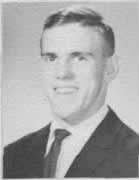 “Then she asked me again if I wanted some more, and I said I did, and she told me to get out of bed again and walk towards her. They did an EKG.” Eventually, the child recovered. In time he became a blur, a boy of energy and vitality with a bullet shaped body that could do things with objects, balls, his feet and hands, that defied the imagination. “Maybe I was good, but I didn’t know it,” he says.
“Then she asked me again if I wanted some more, and I said I did, and she told me to get out of bed again and walk towards her. They did an EKG.” Eventually, the child recovered. In time he became a blur, a boy of energy and vitality with a bullet shaped body that could do things with objects, balls, his feet and hands, that defied the imagination. “Maybe I was good, but I didn’t know it,” he says.
“I just enjoyed what I did.”
Mr. Standring has performed admirably and capable a number of dovetailing roles: student, athlete, coach, husband and father. He is the first to say how lucky he is, but that luck is the residue of hard luck, determination, devotion and belief.
“My cousin wrote an article at Notre Dame shortly after my grandfather died. He remembered me being as small as I was, I would kick footballs over garages. Their family moved down to Danville and they had a barn for their particular garage and I kept kicking it over the garage and he couldn’t understand how I did that. I said, ‘It’s easy. You just take it and kick it.’ I was kicking it over the telephone wires and stuff. It’s just something you acquire.
Family
“My mother’s name was Irene. Her family lived at 7719 S. Clyde, in South Shore. There were eleven kids in the family. The youngest ended up being a priest. The majority of them went to Mount Carmel. One of them went to St. Rita. It’s ironic that I was born on July 16, 1948, sixth day of our lady of Mount Carmel.
“My father was named John Joseph Standring. I’m John Joseph Standring Jr. I go by Jay. I used to be called JJ when I was little, but then it cut off. My father was in the Navy and my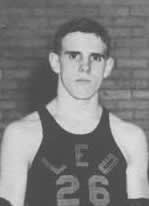 mother and her sister and some of their girlfriends went to one of the Navy Balls. How they met, they just kind of hooked up and got married. They got married on July 4th, and I always thought they could get that day off, since it was our national holiday.
mother and her sister and some of their girlfriends went to one of the Navy Balls. How they met, they just kind of hooked up and got married. They got married on July 4th, and I always thought they could get that day off, since it was our national holiday.
“When I was four years old, we moved to St. Cajetan in Beverly. We lived at 2248 W. 110th Street, a big white wooden house at the turn of the times when the taxes were getting more expensive. One of the admirals or a captain at Morgan Park military academy lived in the house and he had the house turned. It used to face west, because the footage was so big they picked the house up and turned it and then it faced south. That’s where we grew up. In my family there were five boys and one girl. I was the oldest boy and my sister was the oldest in the family.
“Tim went to Quigley South, now St. Rita and from there he went to Notre Dame and then he went to University of Chicago, where he got his masters and his [doctorate]. He’s a 16th century baroque art world historian and he travels the country to authenticate paintings as well as a curator at an art museum in Denver. He played rugby at Notre Dame. My next brother Bob played at Leo, where he was a star in football, basketball and baseball. He ended up getting a scholarship to Illinois and playing football. He graduated from Leo in 1970. I had twin brothers that were eight years younger than me: one went to Illinois State and the other one got into the construction business. Both went to Leo and they are both very successful.
“My mother’s father went to Notre Dame and graduated in 1912. His father graduated from Notre Dame I believe in 1887. A little story about him: when he went to Notre Dame, he wasn’t an athlete but he was a person that had a lot of money. His parents came over on the boat and they had a lot of money. When Notre Dame had to go on some of their road trips and they didn’t have enough money, they’d ask Edward and he would I guess call home or however communications were done back then. His father would send them a check. They would be like a [special] fund to bring Notre Dame to other cities when they traveled.
 “My grandfather went to Harvard Law and became a lawyer. My father grew up in Breckenridge, Minnesota. He was kind of an orphan, and his mother couldn’t afford him to be down here so he lived with his relatives in Minnesota. When he came down here and met my mother and they got married, he went into the service. After the service, he used the [GI] Bill to go to school. He went to Northwestern and graduated from there. He worked for the steel company at 103rd and Avenue Six. From there he worked for a statistical tabulating corporation, working in the early development of the computers, and he’s done that most of his life.
“My grandfather went to Harvard Law and became a lawyer. My father grew up in Breckenridge, Minnesota. He was kind of an orphan, and his mother couldn’t afford him to be down here so he lived with his relatives in Minnesota. When he came down here and met my mother and they got married, he went into the service. After the service, he used the [GI] Bill to go to school. He went to Northwestern and graduated from there. He worked for the steel company at 103rd and Avenue Six. From there he worked for a statistical tabulating corporation, working in the early development of the computers, and he’s done that most of his life.
Coach Standring demonstrated prowess as a young lad, and he was not about to let that slide. He meant to get everything out of his God-given ability as possible. St. Cajetan was a tough neighborhood, the dominant vocations that of fire fighters and police officers. It was the kind of roughhewn, tough place where talent and ability was proved, not taken for granted.
“I grew up in a neighborhood where everybody was older than myself. All of a sudden, when I got to fifth grade, everybody started going up to Kennedy Park. At the Catholic [grammar] school you could not start football until you were in sixth grade. One of the janitors had a team. Sometimes we’d scrimmage the sixth graders. When you got to sixth grade, it was phenomenal. That’s all the kids did was play football. I’d say there were seventy or eighty kids. We had the same coach all three years. He produced some phenomenal teams. You didn’t do anything else but play football. We didn’t have a gym so we used to use the Baptist church or another church down on the hill on Longwood that we also used for basketball. Then we all played Little League and you’d play down at 115th near the tracks. You’d play Pony League there and went on.
The Leo Leap
“Our eighth grade football team went undefeated. Nobody scored on us the whole year. The only two points any team scored on us was when somebody centered the ball over my head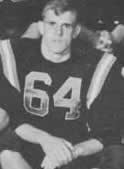 and the ball went out of the end zone for a safety. From that team, everybody just spread out everywhere. At the time, I was offered monetary scholarships. We had heard if you were caught getting a scholarship in high school, the scholarship would be taken away, but more important, you’d not be able to play any sports. My father said, ‘You’re not going to a school that would give you a scholarship.’ Some of my other friends did take the scholarship offers, but I think it all worked out for the best.
and the ball went out of the end zone for a safety. From that team, everybody just spread out everywhere. At the time, I was offered monetary scholarships. We had heard if you were caught getting a scholarship in high school, the scholarship would be taken away, but more important, you’d not be able to play any sports. My father said, ‘You’re not going to a school that would give you a scholarship.’ Some of my other friends did take the scholarship offers, but I think it all worked out for the best.
“I also had an important personal connection to Leo. One of my friends, Jack Gannon, was a year ahead of me. His parents and my parents were very good friends. I really think it was him that got me to come to Leo. I just trusted him.”
Coach Standring entered Leo in the fall of 1962, during a time of great tumult and change, on the South Side and around the country. The declining number of Christian Brothers forced the school to seek out greater numbers of lay teachers, the bulk of them young men entering the teaching profession directly out of college. Economically, the country experienced sharp boom and bust cycles that often meant harsh times for a lot of Catholic families during an era dominated by one-income parent and families with significant numbers of kids.
“All I know is we had the six mouths to feed and my mother went and got two gallons and two loaves of bread every day. We stretched everything out. Times were tough. I could remember numerous times going to the penny jar to buy the milk and the bread. That’s just the way things were. I had a paper route for eight years, four years in grade school and four years in high school.
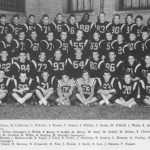 “I delivered the Tribune and Sun-Times. I rode 108th and 109th from Western to Longwood. It was a morning paper route. Finally my senior year I convinced my two other brothers Tim and Bob if they would take the paper route during the week, I’d do it on the weekends. Back then you played the football games on Sunday. That was the only money I could scrape up. My parents didn’t have any money. It helped pay for my high school. The tuition at Leo was $196 a year. You’d ride the bus for 12 cents with a bus card. I took the 111th bus down Vincennes over to Halsted.
“I delivered the Tribune and Sun-Times. I rode 108th and 109th from Western to Longwood. It was a morning paper route. Finally my senior year I convinced my two other brothers Tim and Bob if they would take the paper route during the week, I’d do it on the weekends. Back then you played the football games on Sunday. That was the only money I could scrape up. My parents didn’t have any money. It helped pay for my high school. The tuition at Leo was $196 a year. You’d ride the bus for 12 cents with a bus card. I took the 111th bus down Vincennes over to Halsted.
“Right away at Leo we had really good teams. Most of the kids were from Sabina, St. Leo and some from Little Flower. We played four games [my freshman year]. Bob Foster, who today is the principal at Leo, he had told someone I think after our second game our freshman year, ‘I don’t want to [exaggerate] but I think I have seven or eight guys that are going to go Division I football.’ As it turned out, nine guys from our class ended up getting college scholarships.”
With its imposing architectural structure and four floors, the Leo campus was an imposing one. Most kids during that era lived fairly circumscribed lives. Coming to a big school like Leo was sometimes a jarring transition.
“There were an awful lot of kids. That’s the first thing I remember. I was nervous as heck and I just didn’t know my ability of making the step of going up to high school. I think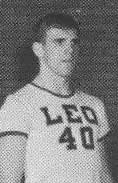 everybody has those feelings. As it turned out it was probably the best choice I ever made. In grammar school I played halfback and defensive back, and I also kicked. We played our championship grade school game against St. Margaret of Scotland. I went to kick an extra point and I made it. In my senior year, we’re playing St. Rita. The score was tied and I went to kick an extra point and I missed it.
everybody has those feelings. As it turned out it was probably the best choice I ever made. In grammar school I played halfback and defensive back, and I also kicked. We played our championship grade school game against St. Margaret of Scotland. I went to kick an extra point and I made it. In my senior year, we’re playing St. Rita. The score was tied and I went to kick an extra point and I missed it.
“I thought, ‘Four years ago in grade school, I made this some place and here in high school, I missed it.’ I wondered, What happened to me.’” That kind of introspection, mixed with candor and self-deprecating wit, characterized the young man’s disposition. He was part of something special. If his nature was to fit in, his talent forced him to stand out. He accepted the responsibility.
“At Leo we had some darn good players and I was lucky enough to be there. We just had a freshman team and a varsity. Like I said, my freshman year we only had four games. We had spring ball. My sophomore year I was starting at defensive back and I was punting. My junior year I was starting both ways. My senior year I played both ways. That was the turn of the time when they started to have platoon football. [That is, fielding separate teams for offense and defense.] During my sophomore year that’s when you could only substitute three players. It was tough back then. When it came to my senior year I don’t think I ever left the field.
Changing times
Leo’s incarnation as school of overwhelmingly South Side Irish was changing. African-American parents wanted opportunity for their sons, a chance at the discipline, toughness and range of a Catholic education. The school adopted, slowly perhaps, but it made allowances for the changing social fabric.
“We had a few black kids come. Leo didn’t have a baseball team then. Most of the black kids ran track. A lot of the black kids didn’t have exposure in grammar school to football, so they didn’t really know what to do. Frank Butler was a year behind me and he ended up getting a scholarship to Michigan State. The neighborhood was predominantly white. I had some friends in St. Leo parish. Most of the basketball kids were from Sabina, and I kind of latched onto them. That was the group of guys I hung out with. The kids from Cajetan I really didn’t have a relationship with them any more.
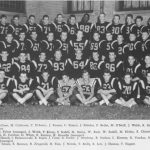 “We had a rule in our house you couldn’t go out at night. You could only go out if there was no school the next day. That’s when Sabina used to have their dances. It used to drive me crazy not being able to go. I think I went one time in four years because we had the Monday off. That was my parents’ rule, and I never regretted it. We also had a rule you couldn’t drive a car until you were 18. My birthday was in July and by then I’d already graduated from high school. I had friends that drove and they used drive. I guess I had a somewhat [sheltered] life because I never went out. I wanted to study, I wanted to go to college and I wanted to do well at sports.
“We had a rule in our house you couldn’t go out at night. You could only go out if there was no school the next day. That’s when Sabina used to have their dances. It used to drive me crazy not being able to go. I think I went one time in four years because we had the Monday off. That was my parents’ rule, and I never regretted it. We also had a rule you couldn’t drive a car until you were 18. My birthday was in July and by then I’d already graduated from high school. I had friends that drove and they used drive. I guess I had a somewhat [sheltered] life because I never went out. I wanted to study, I wanted to go to college and I wanted to do well at sports.
For many young men, activity is what defines their early existence, where they develop the self-confidence and begin to grasp their own self-worth. Musicians, athletes, students, academics, it comes in different ways. It certainly eases the pain and awkwardness of those socially difficult years.
“My junior year we made the playoffs and I think we lost to Mendel. My senior year we tied Rita and we played Gordon Tech at Soldier Field Stadium. At halftime, I was sprawled out, I was so tired and the manager came out and said: ‘There are some Notre Dame people here and if you play well, you can get a scholarship.’ I told him just to get away. We beat Gordon Tech and then we played Loyola the following week but we lost to them.
It was the worst game that everybody had. Loyola beat us up and down. They won fair and square. I played running back but I also played flanker. We had a quarterback that could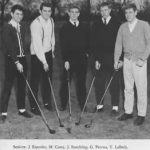 throw the ball a mile but I could never got off the line. I was a big part of the offense. I could catch the ball and run like the wind, and it was so easy for me. Loyola would double team me, and I could never get the ball. Loyola ended up being in the Prep Bowl.”
throw the ball a mile but I could never got off the line. I was a big part of the offense. I could catch the ball and run like the wind, and it was so easy for me. Loyola would double team me, and I could never get the ball. Loyola ended up being in the Prep Bowl.”
There were many schools interested in coach Standring. In return there was really only school that captured his fancy. It was the school for which his family had its own lifeline.
“Ever since I was growing up, my [maternal] grandfather he kept asking when am I going to figure out where I was going to college. Of course, I always wanted to say Notre Dame, but I wanted to get in academically first. I was a solid student at Leo, but I did poorly on my ACT. Fortunately I did very well on my SAT, and that’s what I got me into Notre Dame.
“There were quite few other Big Ten schools and letters from other major universities, but honest to God, I never opened them up because if I could go to Notre Dame, that was it. It’s funny because when the time came to making a decision, we were sitting right next to [legendary Notre Dame football coach] Ara Parseghian. My mom and dad and myself and he put this piece of paper right in front of me. He said, ‘Well, Jay, I’m going to offer you a four-year scholarship and you won’t have to pay for a thing. All I want you to do is sign here.’
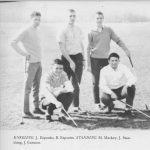 “I froze. I wanted to, but I wondered could I really play there. My father is kicking me under the table. I asked him if I could go home and think about it. I went home for about a week. I asked my head coach Bob Hanlon, who was always very truthful with me. I said, ‘I could go a lot of places, but I’d like to go Notre Dame.’ Coach said, ‘If you make up your mind to go to Notre Dame and play, you’ll play. I’m not going to say any more.’ They called me about every other night and finally I said, ‘Yes, I’d like to go there.’ I was just elated.
“I froze. I wanted to, but I wondered could I really play there. My father is kicking me under the table. I asked him if I could go home and think about it. I went home for about a week. I asked my head coach Bob Hanlon, who was always very truthful with me. I said, ‘I could go a lot of places, but I’d like to go Notre Dame.’ Coach said, ‘If you make up your mind to go to Notre Dame and play, you’ll play. I’m not going to say any more.’ They called me about every other night and finally I said, ‘Yes, I’d like to go there.’ I was just elated.
The Irish
“I graduated in four years from Notre Dame. My freshman year, we did not play varsity. Our freshman year was the first year Notre Dame played freshman games. We played Michigan State and Pittsburgh. I was the starting tailback.
We beat Michigan State’s freshman 30-27 the night before the famous game that ended in the 10-10 tie [when Notre Dame and Michigan State were ranked the top two teams in the country]. We were on the sideline, wearing trench coats, ties and suits.
“Going into the spring of my freshman year we had spring football. I look at the offensive depth chart and I didn’t see my name there. A guy said I was over on defense. I was deflated. I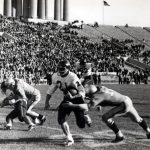 called home and I said I was playing defense. I said I don’t like this but what can I do. My father said, ‘You’re on a full scholarship. Don’t worry about a thing. It’s like you work for a department store. Instead of selling shoes, you’re selling shirts. Make the best of it.’
called home and I said I was playing defense. I said I don’t like this but what can I do. My father said, ‘You’re on a full scholarship. Don’t worry about a thing. It’s like you work for a department store. Instead of selling shoes, you’re selling shirts. Make the best of it.’
“I was on the second team and the week before our first game I broke my collarbone and shoulder and had a body cast from my waist to my neck for six months. They ran a screen in my direction. They used to call me ‘Crazy Jay’ because I was a crazy guy that would do anything. I broke up the play but I got a concussion that was pretty bad.
“My junior year I started some games, I had three interceptions. In the spring of my junior year I broke my leg playing intramural hockey. On senior year I was on special teams. I had a great time. I went to the Cotton Bowl.” It was Notre Dame’s first bowl game since 1925. The Irish jumped out to a 10-0 lead behind the play of quarterback Joe Theismann, but the Longhorns recovered. They beat the Irish 21-17. President Johnson visited the locker room after the game.
Coach Standring graduated from Notre Dame with a degree in sociology. If playing football and attending school at Notre Dame insulated him from the radical protest movements and social tumult gripping most college campuses at the time, he was about to get his own awakening.
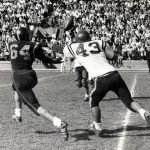 “Vietnam was going on, and I had a low number. My brother Tim was a couple of years behind me at Notre Dame and his number was in the three hundreds. I had 126 and I was going to be going. I signed up for the National Guard in Nevada and I was going to go out there and teach and coach and be in the Guard. Three days before I was going to leave, I received a letter from the draft board saying: ‘Not qualified for the armed forces under current standards.’ I went to the draft board and they opened the book and they said: ‘Nope. Can’t go. See you. Goodbye.’
“Vietnam was going on, and I had a low number. My brother Tim was a couple of years behind me at Notre Dame and his number was in the three hundreds. I had 126 and I was going to be going. I signed up for the National Guard in Nevada and I was going to go out there and teach and coach and be in the Guard. Three days before I was going to leave, I received a letter from the draft board saying: ‘Not qualified for the armed forces under current standards.’ I went to the draft board and they opened the book and they said: ‘Nope. Can’t go. See you. Goodbye.’
Coach Standring theorizes the various injuries he incurred playing football at Notre Dame and the childhood illness precluded him from having to serve in the military. After Notre Dame, he spent a year teaching History and English at Juneau Public High School in Milwaukee. “One day a couple of guys came and said, ‘How’d you like to come back to the Chicago Catholic League’? He spent a semester at Mount Carmel, Leo’s great traditional rival, but he got caught in staff cutbacks in the wake of the school’s seriously declining enrollment. Returning home
Coach Standring returned to Leo as a teacher and coach. There was one noticeable addition, his wife Julie. “She was the sister of one of my best friends, and I never seriously thought of her as anything other than my friend’s sister. She was always going out with this other guy, and my friend why didn’t I ask her out for this social event. I asked him about the other guy and he told me they broke up. We went out for a couple of years and I proposed to her at the Orange Bowl.” They had two sons, John Joseph III (who is more commonly known as JJ) and Paul.
The coach’s return to Leo was fairly brief as he was given a plush new coaching assignment at NAIA Northeastern University on the city’s northwest side. He coached there for 13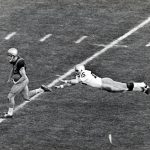 years. When the school dropped their football program, coach Standring shifted to the University of Chicago. “I told [the administrators] I’m a family man and I wanted to be around my own kids.” That lifelong dream of coaching his own kids came to fruition when the coach accepted a coaching and teaching job at St. Rita. “I coached JJ in football, basketball and baseball and it was a dream come true.” The coach’s two sons certainly inherited his kicking prowess. Both were top-caliber prospects. JJ played baseball and kicked for the Northwestern football team. JJ holds Northwestern’s career record for cumulative punting yardage. Paul was a top kicker at the University of Wisconsin.
years. When the school dropped their football program, coach Standring shifted to the University of Chicago. “I told [the administrators] I’m a family man and I wanted to be around my own kids.” That lifelong dream of coaching his own kids came to fruition when the coach accepted a coaching and teaching job at St. Rita. “I coached JJ in football, basketball and baseball and it was a dream come true.” The coach’s two sons certainly inherited his kicking prowess. Both were top-caliber prospects. JJ played baseball and kicked for the Northwestern football team. JJ holds Northwestern’s career record for cumulative punting yardage. Paul was a top kicker at the University of Wisconsin.
“JJ played in one bowl game with Northwestern, Paul played in five. Notre Dame had a late interest in JJ to play baseball, but he had a 90 percent baseball scholarship to Northwestern. That made my father very proud. His first punt ever at Northwestern was 69 yards. His first time up to bat for the baseball team, he hit a home run. I went and got the ball.” Coach Standring earned his Master’s from Chicago State and now runs the physical education department at St. Rita. He coaches the freshman football team, helping mold them into varsity players. His wife is an athletic administrator at the school. JJ is on the varsity staff as a kicking specialist.
He is part of a different program though Leo left an indelible imprint. “The Catholic education was very important to me. Today, I go to church every day.” The coach’s life has been one of accomplishment, excitement and daring, on and off the field. Now he holds the ultimate responsibility of teacher, mentor and spiritual leader.
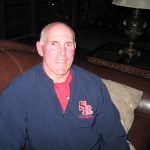
Coach Standring is a genuine example of a Christian man. He is a great role model, teacher and coach. He is a great man and I am proud to call him a friend for life. Thank You Coach.
coach standring , is my favorite teacher, i have a great deal of respect for him,and in my life time ,have never met a finer person, james ojer class of 78.
Jay also kicked an extra point out of St. Rita’s stadium in the grammar school semi-finial game against St. John Fisher. St. Cajetan was old hat in playoffs; SJF a first timer. SJF showed up, played hard but were plain and simply out coached, less prepared and what really counts: did not really expect to win. They didn’t, losing 53-0. St. Margaret of Scotland beat St. Christina by a coin flip after tying in regular time. Christina then beat SJF 20-0 in the 3rd Place Game, but wrecked the field for the title game. It had snowed that day and when the 3rd Place Game was over the field was a quagmire. So Jay & Roger [St. Rita alum] were slowed drastically; ditto for Jerry Hickey on SMofS side [another St. Rita alum]. But St. Cajetan prevailed, 12-2.
I got to play against and finally with Jay in the parks. Kennedy Park, of course, but Munroe Playground under the lights, too. Always a class act, a top notch guy. I am lucky to have known him and won some games with him. I knew most of the St. Cajetan players or at very least who they were; even Buster [Leo] my kissin’ cousin.. Most all ended up in good stead in life, as I think Mr. Doherty’s coaching and preparing his boys for life beyond football, along with half the student body they dressed and in a rare no Kennedy Park game carted in a large truck with huge speaker phones bellowing out they were coming and then the game itself. Sadly, thanks to Jimmy Arneberg mainly, my father refused to let me attend Leo. So my wayward teens began. But as a senior playing Mr. Arneberg’s undefeated Homewood-Flossmoor team [which hit me later in life], we shut them out and like Mr. Arneberg a 5-8 165# guard had a pretty good game. the game over [Like he had done to the vanquished in a Prep Bowl Leo victory to the defeated] he came across the field and grab-hugged me yelling in my ear I played just like my father.
From bus trips and thumbing rides to the old Shewbridge field/Stadium to watch Leo while in grade school at St. Thomas More, Leo and Jay hold many fond memories. thank you all.